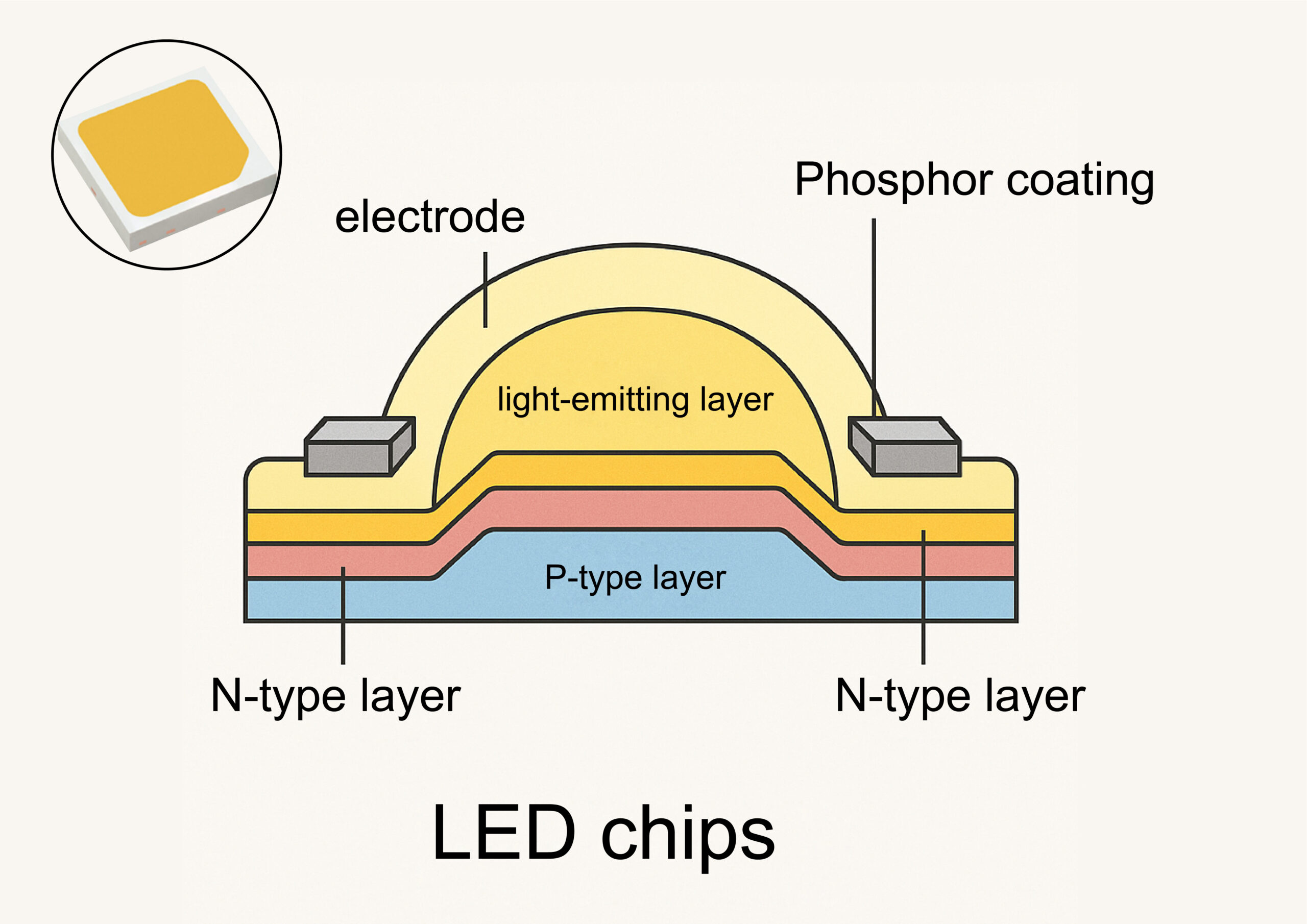
How to Choose High-Quality LED Chips—The Core Guarantee of Outdoor Luminaire Performance and Lifespan
In the field of outdoor lighting, LED chips are the core component that determines luminaire performance, brightness, color stability, and lifespan. Whether it’s an LED street light, floodlight, garden light, or high-pole light, the chip choice directly impacts the luminaire’s performance in a variety of harsh environments. Understanding the correct LED chip selection is crucial for customers seeking stable quality and long-term profitability.
1. Clarify Luminous Efficacy Requirements
Luminous efficacy (lm/W) is a key indicator of the luminous efficiency of an LED chip. For outdoor luminaires, it’s recommended to choose high-efficiency chips with a luminous efficacy of 150 lm/W or higher. This achieves higher brightness at the same wattage, reducing energy consumption and lowering long-term operating costs. For example, for highway and large plaza lighting, high-end chips with a luminous efficacy of 160–170 lm/W can meet the dual requirements of high illumination and energy savings.
2. Pay attention to the chip package type
Common LED chip packages include PCT, EMC, and ceramic packages.
PCT packages: Moderately expensive and suitable for mid-power luminaires.
EMC packaging: Offers improved heat resistance and UV resistance, making it suitable for high-temperature environments.
Ceramic packaging: Offers excellent heat dissipation and high reliability, often used in high-end engineering projects.
For outdoor lighting, EMC or ceramic packaging effectively protects against aging issues caused by summer heat and direct sunlight.
3. Color Temperature and Color Rendering Index (CCT & CRI)
Common color temperatures for outdoor lighting range from 3000K, 4000K, 5000K, and 6500K:
3000K (warm white light): Suitable for courtyard and landscape lighting, creating a warm atmosphere.
4000K (neutral light): Suitable for commercial areas and pedestrian streets, offering high color reproduction.
5000K–6500K (cool white light): Suitable for locations requiring high brightness and clarity, such as roads and squares.
The color rendering index (CRI) should be ≥70. For high-end commercial or stadium lighting, a CRI ≥80 is recommended to ensure faithful color reproduction.
4. Weather Resistance and Stability
Outdoor lighting fixtures are subject to prolonged operation in environments with high and low temperatures, humidity, and dust. Therefore, LED chips must exhibit the following:
Low lumen decay: High-quality chips maintain a lumen maintenance rate of ≥95% after 6,000 hours.
High-temperature resistance: Junction temperatures can withstand temperatures exceeding 150°C, preventing failure caused by high temperatures.
UV resistance: UV resistance extends service life in outdoor exposure.
5. Brand and Quality Certification
Choosing internationally renowned LED chip brands (such as Lumileds, Cree, Osram, Nichia, and San’an) ensures batch consistency and long-term stability.
Also, pay attention to chip test reports and certifications, such as:
LM-80 life test report
IES optical test report
RoHS and CE environmental and safety certifications
6. Consistency and Batch Control
LED chips must be strictly binned for color temperature, brightness, and VF (forward voltage). High-quality chips are precisely binned before shipment to ensure consistent brightness and color across lamps within the same batch, avoiding color variations.
7. Driver Matching and System Design
Even high-end chips can suffer from overcurrent or overheating if the driver power supply is not properly matched, shortening their lifespan. Therefore, when selecting a chip, consider its compatibility with the driver solution to ensure:
The drive current is stable within the chip’s rated range
Overtemperature and overvoltage protection are provided
Optimize heat dissipation to reduce junction temperature
8. Recommendations for Typical Outdoor Applications
Street Lighting: Select high-efficiency, EMC-encapsulated, 6500K cool white light, and a CRI ≥ 70
Stadium Lighting: Select high-color rendering index (CRI) ≥ 80, ceramic package, and high-power chips
Landscaping: Select warm white light (3000K), high-color rendering index (CRI), and prioritize color performance
Ports and terminals: Select highly weather-resistant chips that are resistant to salt spray corrosion and UV rays
Summary: Selecting high-quality LED chips requires more than a single comparison of performance indicators; rather, it requires a comprehensive consideration of multiple factors, including luminous efficacy, packaging, color temperature, CRI, weather resistance, brand, and batch control. For outdoor lighting projects, a high-quality LED chip not only provides a stable and energy-efficient light source but also reduces ongoing maintenance costs, thereby improving the overall project’s return on investment.
As a professional outdoor lighting manufacturer, we always insist on using high-quality LED chips, and combine them with advanced heat dissipation structure and drive control to provide customers with reliable and long-life lighting solutions, so that your project can maintain excellent lighting performance in any environment.
